Marbled Electric Ray
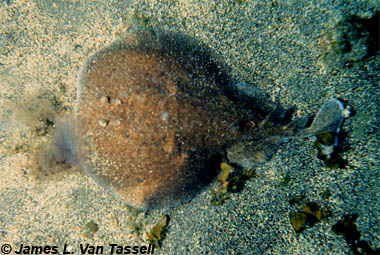
Torpedo marmorata
This solitary coastal ray has electric organs on its pectoral disc that can stun a human or kill a fish. It is pale brown with dark brown mottling, and has two small dorsal fins on its stout tail near its large caudal fin.
Usually it can be found on muddy or sandy bottoms of rocky reefs or seagrass beds where it camouflages itself in order to ambush prey like small fish and some invertebrates.
Order – Torpediniformes
Family – Torpedinidae
Genus – Torpedo
Species – marmorata
Common Names
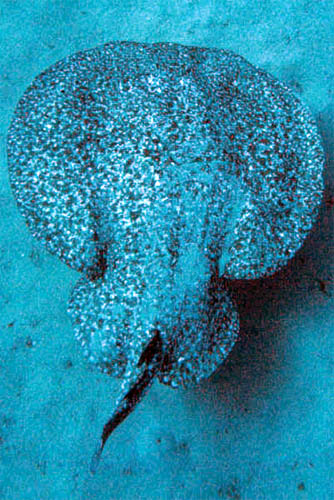
English language common names include marbled electric ray, common crampfish, marbled torpedo, and spotted torpedo. Other common names are battinetta (Italian), dali (French), dormideira (Portuguese), dormihouso (French), dourmillouse (French), dretwa pstra (Polish), elektrický rejnok mramorovaný (Czech), elektrisk rokke (Danish), endourmidouijda (French), flekket el-rokke (Norwegian), galina (French), gemarmerde sidderrog (Dutch), guetj (Wolof), haddiela (Maltese), haddiela komuni (Maltese), haddiela tax-xokk (Maltese), lakhmah (Arabic), lekelielektrik baligi (Turkish), lekeliuyusturan baligi (Turkish), lukmah kahrabaiah (Arabic), marmaromoudiastra (Greek), marmelzitterrochen (German), marmorerad (Swedish), marmorerad darrocka (Swedish), marmoreret elrokke (Danish), marmorierter zitterrochen (German), marmorisähkörausku (Finnish), meudj mbenjann (Wolof), ndeugue sokbor (Wolof), obyknovennyi (Russian), oiwilah’baiah (Arabic), oiwilah’hmah kahrabaiah (Arabic), peshk elektrik i mermerte (Albanian), raad (Arabic), raie électrique (French), sa Nacida (Italian), samtia (Arabic), sgranfo (Italian), tembladeira (Spanish), tembladera (Spanish), tembladora (Spanish), thimithirandi (Malayalam), tormentim (Portuguese), tormeutim (Portuguese), torpedine (Italian), torpedine bruna (Italian), torpedine marezza (Italian), torpedine marezzata (Italian), torpedine marmorata (Italian), torpille (French), torpille marbrée (French), tremblard (French), tremble lisse (French), trembleuse (French), tremblo (Italian), tremedeira (Portuguese), tremelga (Portuguese), tremelga-marmoreada (Portuguese), tremielga (Spanish), tremoixe (Italian), tremola (Italian), tremola janca (Italian), Tremolina mármol (Spanish), tremula (Italian), tremula antisicca (Italian), tremula biunna (Italian), tremula i rina (Italian), tremula janca (Italian), tremula liscia (Italian), tremula marmulina (Italian), tremula niura (Italian), tremuló (Spanish), tremuloya (Spanish), tremulusa (Italian), treppaine (Italian), trimielga (Spanish), trompigliola (Italian), tubaq (Arabic), vaca enrampadora (Spanish), vaca tremoladora (Spanish), vaca tremolosa (Spanish), and zitterrochen (German).
Importance to Humans
In some regions such as the Mediterranean Sea, electric rays are taken as bycatch in commercial fisheries using trawls. These rays are usually discarded at sea resulting in very little data on the catches of electric rays. It is currently of no commercial value or interest to fisheries, drawing only curiosity due to its ability to produce electrical charges.
Danger to Humans
A large adult marbled electric ray can deliver a painful and stunning electric charge strong enough to disable a person. The primary threat to life is becoming disoriented underwater after receiving the jolt of up to 200 volts. However, it is extremely unlikely that the electric charge could lead to cardiac arrest or ventricular fibrillation in humans.
Conservation
> Check the status of the marbled electric ray at the IUCN website.
The IUCN is a global union of states, governmental agencies, and non-governmental organizations in a partnership that assesses the conservation status of species.
Geographical Distribution
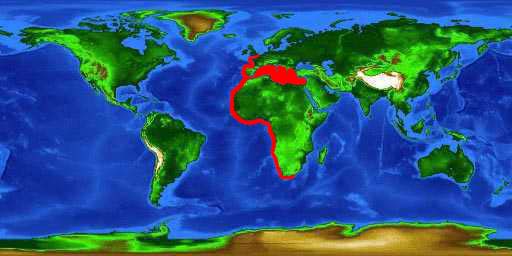
The marbled electric ray lives in the eastern Atlantic Ocean from the northern British Isles south to the Cape of Good Hope, South Africa and is uncommon in the southern portion of the North Sea. It is also present in the Mediterranean Sea.
Habitat
Generally, the marbled electric ray is found in seagrass, rocky reefs, and adjacent sandy and muddy bottoms at depths from 33-98 feet (10-30 m) although it has been reported at depths to 328 feet (100 m) in the Mediterranean Sea. It avoids water temperatures above 68 °F (20 °C). This species is nocturnal, burying itself during daylight hours with only its eyes and spiracles above the sediments.
Biology
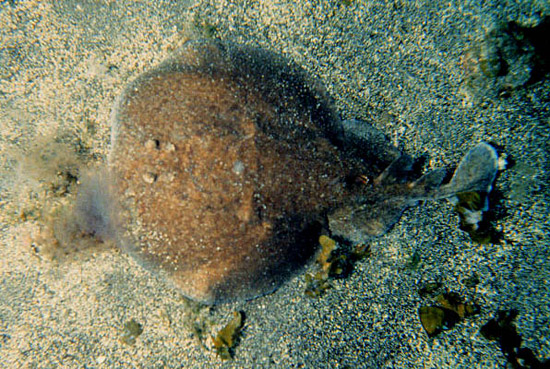
Distinctive Features
The marbled electric ray has a rounded disc and a short thick tail with a large caudal fin. There are two rounded dorsal fins located close together on the tail and are nearly equal in size with the first dorsal fin only slightly larger than the second dorsal.
A species similar in appearance to the marbled electric ray is the Atlantic torpedo (T. nobiliana), however the two species are easy to distinguish from each other by their coloration. The marbled electric ray has a mottled brown coloration on the body in contrast to the Atlantic torpedo that is dark grayish blue to brown in color with no mottled pattern.
Coloration
The dorsal surface of this electric ray is pale brown with dark brown mottling for which this species gets it common name. The ventral surface is creamy white in color.
Dentition
The small mouth contains small, single-cusped teeth arranged in pavement-like bands in both jaws.
Denticles
The skin of the marbled electric ray is smooth with the exception of six to eight papillae-like tentacles present around the inner margins of spiracles.
Size, Age, and Growth
The marbled electric ray reaches a maximum total length of 39 inches (100 cm) making it much smaller than the Atlantic torpedo (T. nobiliana). Males reach maturity at approximately 10 inches (25.1 cm) total length and females at 12 inches (31.2 cm) total length, corresponding to approximately 5 years of age. The life span of the marbled electric ray is about 15-20 years with females living longer than males.
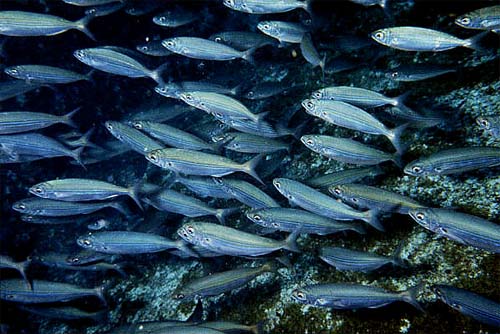
Food Habits
It ambushes and envelops fish with its pectoral fins, delivering a powerful electric shock from the electric organs. These electric organs are located in the pectoral fins and produces a charge up to 200 volts with a frequency up to 600 Hz that will stun or kill a fish before the torpedo eats it.
This ray can distend its jaws allowing it to swallow fishes larger than thought possible based on the width of the mouth when it is closed. Prey items of the marbled electric ray include small fishes such as gobies, mullet, mackerel, bogue, pandora, and damselfish among many others. It is also known to feed on benthic invertebrates.
Reproduction
The reproductive mode of this ray is ovoviviparous with embryos feeding initially on yolk, then receiving additional nourishment from the mother by indirect absorption of uterine “milk” that is enriched with mucus, fat and protein. Although there is little known about the reproduction of the marbled electric ray, it is thought that the gestation period lasts approximately 9-10 months.
Birth occurs in November and December with each female releasing 5-32 young, depending on the size of the female ray. Each young ray measures 4-6 inches (10-14 cm) in length at birth and has fully functional electric organs it can use immediately to capture prey.
Predators
This ray has few natural predators due to its formidable electric capabilities and large size. Predators such as sharks and other large carnivorous fishes seldom confront electric rays.
Parasites
Empruthotrema torpedinis, a mongenean, is a parasite documented from the nasal fossae of the marbled electric ray as well as other species of electric rays in the Mediterranean Sea. Additional parasites of this ray are the nematodes Mawsonascaris pastinacae and Ascaris torpedinis.
Taxonomy
The marbled electric ray was originally described as Torpedo marmorata by Risso in 1810. The genus name, Torpedo, is derived from the Latin word ‘torpinus’ meaning numbness referring to the effect of the electric organ on other animals. Synonyms referring to this species in past scientific literature include Torpedo immaculata Rafinesque 1810, Torpedo punctata Rafinesque 1810, Torpedo galvani Risso 1810, Torpedo vulgaris Fleming 1828, Torpedo diversicolor Davy 1834,Torpedo picta Lowe 1843, and Torpedo trepidans Valenciennes 1843.
Prepared by: Cathleen Bester